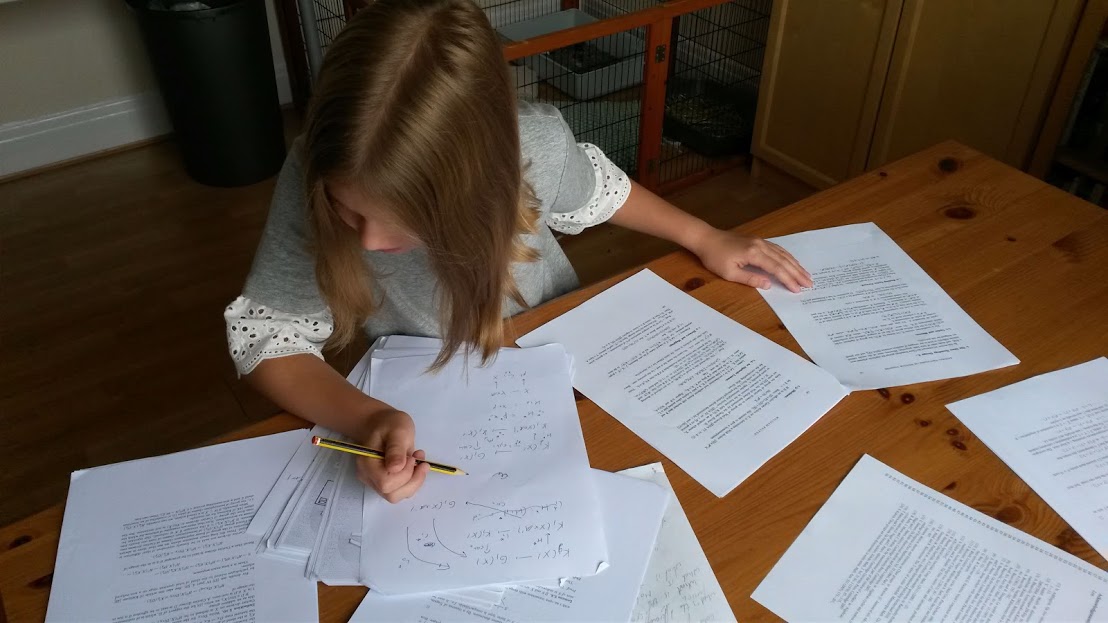When it comes to mathematics, the population is divided into two distinct groups. The first group holds an opinion that maths is easy and straightforward, while what the second group claims that maths is very difficult and there is some innate mathematical “ability” that they lack.
This situation seems to be special to mathematics, as probably no one claims that they have no ability to study Biology, History, or English literature. In this series of posts we try to investigate what it is that makes maths unique, to discuss rote learning versus mathematical creativity and their role in children’s education. We also explain links between mathematical education, modern studies in abstract mathematics, and applications of mathematical skills in the real world.
“My first Maths”
Let’s look at how children first encounter maths. Most four year old children enjoy counting small collections of objects (one, two, three…). So far so good.
The next important stage, is simple addition (2+2, 3+2, and so on). Already at this stage we can see, what it takes to be good at mathematics: by practicing, children acquire certain familiarity and intuition about how numbers work. For example, an excellent exercise for young children who are learning addition is to get them to memorize pairs that make up 10, that is 1+9, 2+8, 3+7, 4+6, 5+5. This skill is key to subtraction, as well as to addition of multi-digit numbers later on. In fact “good” mathematics very often feels like a game.
Learning times tables
The next important stage is learning times tables. Multiplication by two, that is doubling, comes easily to most children. However, multiplication tables themselves are naturally perceived as long and intimidating. Here too we see what mathematics is all about. First of all, let us recall there are two ways of learning mathematics. The first way, sometimes called rote learning, is about constant repetition and memorizing. The other way which we may call meaningful learning (or mathematical creativity) makes an emphasis on understanding rather than memorization .
Rote learning vs meaningful learning approach
In learning mathematics, perhaps as in many other subjects, rote learning and meaningful learning can effectively complement each other. Let us compare the two approaches for times tables. Once a basic idea about what multiplication does is familiar, intensive rote learning allows to memorize the whole 12 x 12 table in just a couple of months. In contrast meaningful learning would take a long time and not really apply to the problem, as the question such as why is 7 x 7 = 49 does not really make sense. On the deeper level, and again this is what mathematics often is about, is that it all links together. For example, one can say that 7 x 7 = 49 because 6 x 7 = 42. This may not really make sense but the point is once certain familiarity with the whole table is there, individual entries start making more sense. That is, rote learning is sometimes a precursor to understanding.
In this example we also see one of the main difficulties that people encounter with mathematics. It comes in layers, and learning each new layer requires strong understanding of the previous ones. What we mean is that learning and understanding times tables is very difficult without good grasp of addition.
Mathematical creativity and times tables
We can also demonstrate mathematical creativity alongside the rote learning of times tables. Mathematical creativity is often about coming up with new problems, and turning everything upside down and inside out. For example, an excellent exercise on times tables is to ask: is 36 in times tables? The answer of course is yes, and it comes in twice, as 4 x 9 and 6 x 6. Of course, one can swap the two factors such as 9 x 4, but let’s agree that it’s the same way of making up 36 as 4 x 9, rather than a different way.
Next we may consider a whole list of numbers, say 30, 31, 32, 33, 34, 35. Some of these are in times tables while others are not. Indeed, we have
30 = 5 x 6 = 3 x 10
32 = 4 x 8
33 = 3 x 11
35 = 5 x 7
Now what about the remaining two numbers: 31 and 34? They are not in the times tables. But why? The reason why 34 is not in times tables is that while 34 = 2 x 17, the second factor 17 is not included in our times tables. On the other hand, the number 31 can not be divided by anything else than itself and one. That is 31 = 1 x 31 is the only way we can factor it out. Such numbers are called prime numbers, and this connects times tables directly to modern branches of modern abstract mathematics, called Number Theory, where professional mathematicians answer questions such as “what is the probability that a given number is prime”? Not bad for “boring” times tables!
On the role of Maths workshops in teaching mathematics in Primary School
So how can the teachers infuse creativity into classroom maths? You can invent all sorts of maths problems (like space maths!) that involve subtracting, dividing, converting units of measurements, telling time and practicing times tables.
Another way is to book a Maths workshop! Delivered by experienced mathematicians, educators and presenters, they will help the teachers infuse creativity into the traditional subject and get the children excited and enthusiastic about Maths, be it shapes and angles, weights and volumes, times tables or even history of mathematics!
Maths is fun!

